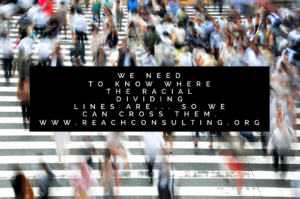The last few weeks has been hard for Americans. We’ve all seen the violence, the videos, the news broadcasts. The racial divide that is creeping up in our society is quite staggering and sad. Like much of what we all see online about the shootings and police and riots, we at Reach Consulting believe online forums for discussion about race and racism is unhelpful. But it most certainly needs to be discussed, the truth teased out, prayed over, and ultimately we all need to come to a point where heart-change occurs in all of us.
This post is not about all the current events surrounding the shootings or the catch phrases of “black lives matter” or “all lives matter” or “police lives matter.” It is not about racism or which side is correct. But it is about race. As it has been for decades upon decades, the Church in America is still very racially separated. Sunday is the most racially divided day of the week.

When you stand up on Sunday morning, ready to teach, what do you see? Are most of the faces staring at you white? Mostly black? Mostly Hispanic? Why is that? Does what you see accurately reflect the neighborhood in which your church resides? Are you really reaching across cultures and ethnicities? Statistically speaking, it most likely does not.
We find that many churches (if not most) do not reflect the racial diversity found within the churches own neighborhood. With the Hispanic population’s rapid growth throughout the United States, many predominately white and black churches do not reach them. Many predominately white churches are located within neighborhoods that have significantly more blacks than what is represented at the church. It goes both ways.
We hear many pastors say they want their church to better reflect the community in which they minister, but don’t know where to begin. Many cannot accurately define what portion of their community truly is black, white, latino, asian, etc. We think the best place to start is by knowing what your community actually is comprised of. Don’t guess, find out!
The US Census Bureau is the best place to start. With data collected every ten years and updated regularly with other information, the Census Bureau website is a wealth of information! For specific ethnicity data for your location, go here.
I remember the first time I learned I could research this level of information for free and so quickly. I was on staff at a large church and our executive team was discussing how best to reach the surrounding neighborhoods. After reviewing the census data found online, I had no idea that less than a mile from our campus was a massive population of south-east Asians. Thousands upon thousands were just within our grasp! It greatly altered our conversation because we were realizing most of our congregation was white, sprinkled with a few Hispanics.
There is a racial divide. It is not just in our city economics or our city maps. It is in our city churches. We need to learn what is on the other side of the street, on the other side of the city, and on the other side of the churches. Knowing what your neighborhood is truly comprised of is a great first start to racial inclusivity. It will allow you to better know what your options and ministry focus should be.
We need to know where the racial dividing lines are…so we can cross them. Jesus reached out to those who were not like Him. He walked across the street and met people who had nothing in common with Him and He did this so he could share His message of eternal life. Why? Because he knew that no matter what ethnicity they were, they still needed a Savior.
Fixing racial division starts with listening, understanding, researching, recognizing past wrongs and sins, and working together to fix the discrepancies. It starts with our churches. And as a church leader, it starts with you. Let’s all work together to shrink the racial divide within our churches.